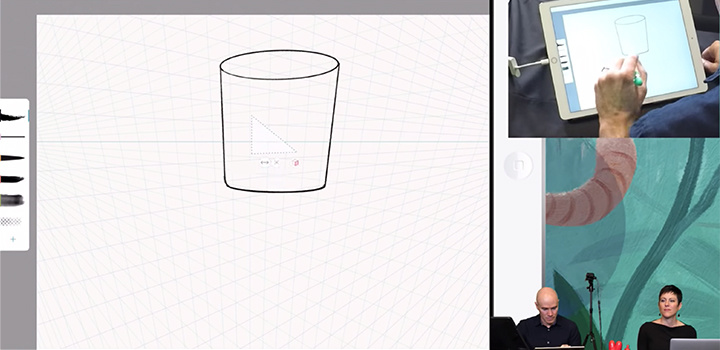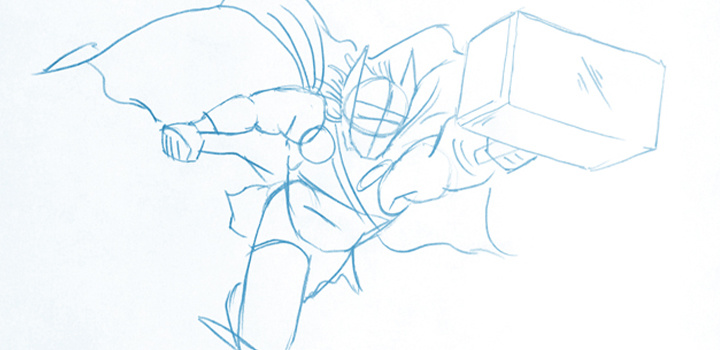วิธีสร้างศิลปะหนังสือการ์ตูน
ไม่ว่าเป้าหมายของคุณจะเป็นงานวาดหนังสือการ์ตูนซูเปอร์ฮีโร่หรือสร้างนิยายภาพอินดี้ คุณจำเป็นจะต้องเข้าใจวิธีการเล่าเรื่องราวผ่านรูปภาพทีละรูปเพื่อที่จะเป็นนักวาดการ์ตูนที่ประสบความสำเร็จ

จุดเริ่มต้นของเรื่องราวการวาดหนังสือการ์ตูนของคุณเริ่มต้นที่ไหน
หนังสือการ์ตูนเป็นรูปแบบศิลปะการบรรยายในเชิงพาณิชย์ สื่อดังกล่าวครอบคลุมประเภทและรูปแบบที่แตกต่างหลากหลาย ตั้งแต่การ์ตูนซูเปอร์ฮีโร่ดั้งเดิมของ Steve Ditko ผู้ร่วมสร้างสไปเดอร์-แมน ไปจนถึงนิยายวัยรุ่นอัตชีวประวัติของ Raina Telgemeier เรื่อง Smile ไปจนถึงภาพวาดด้วยหมึกของ Goseki Kojima ในมังงะเรื่อง Lone Wolf and Cub สิ่งที่เป็นจุดร่วมของศิลปะหนังสือการ์ตูนคือการเล่าเรื่องราวโดยการวางภาพแต่ละภาพต่อกัน ซึ่งเป็นเหตุผลที่สื่อชนิดนี้มักถูกเรียกว่า “การเล่าเรื่องตามลำดับ” แม้ว่าเป้าหมายของคุณจะเป็นการวาดภาพหน้าปกหนังสือการ์ตูน แต่การเรียนรู้หลักการเล่าเรื่องของงานวาดการ์ตูนที่ดีนั้นเป็นสิ่งจำเป็นในการพัฒนาทักษะต่างๆ หากคุณต้องการประกอบอาชีพที่มีการแข่งขันสูงนี้
พื้นฐานก่อนจะมาเป็น Batman
“องค์ประกอบหลักๆ ของหนังสือการ์ตูนสามารถแบ่งออกเป็นสามส่วนให้คุณได้ศึกษา” นักวาดการ์ตูนและอาจารย์ Phillip Sevy กล่าว “ซึ่งก็คือกายวิภาคศาสตร์ของมนุษย์ มุมมอง และการเล่าเรื่องด้วยภาพ” ก่อนที่คุณจะเริ่มต้นทำให้งานของคุณปรากฏที่หน้าสำนักพิมพ์ยักษ์ใหญ่อย่าง Marvel และ DC Comics คุณจำเป็นจะต้องขัดเกลาทักษะสำคัญเหล่านี้ก่อน
การเรียนวาดภาพเหมือนและการวาดภาพหุ่นนิ่งเป็นวิธีที่ดีในการพัฒนาความสามารถในการวาดภาพกายวิภาคของมนุษย์ ซึ่งเป็นทักษะที่สำคัญเมื่อคุณอาจจะต้องวาดภาพคนที่กำลังบิน กำลังตกลงมา กำลังวิ่ง หรือแค่กำลังพูดคุยกันอยู่ตามบทของการ์ตูน แม้ว่างานวาดการ์ตูนจะสามารถมีตัวละครที่มีลักษณะทางกายภาพเกินจริงอย่างงานวาดดั้งเดิมของ Jack Kirby ผู้ร่วมสร้าง Captain America แต่สัดส่วนที่ถูกต้องแม่นยำยังถือเป็นเรื่องสำคัญและเป็นสิ่งที่บรรณาธิการผู้ว่าจ้างจะพิจารณาจากงานของคุณโดยละเอียด


Comics artists also need to be able to draw city streets, interrogation rooms, and even sci-fi space stations as the story dictates, and properly place characters within those environments — and you’ll have to do it on a deadline. Drawing apps like Adobe Fresco and Adobe Photoshop Sketch have a perspective grid function that allows you to add two-point perspective or graph grids to a file as you illustrate — a great way to help you master perspective drawing. “Use reference photos and images,” artist Jen Bartel suggests. “Working in comics, artists will trace parts of backgrounds — anything that helps us speed up the process.”

See a perspective grid in action.
Watch artist Kyle T. Webster turn on and use a perspective grid to sketch a robot.
Storytelling is of the utmost importance.
Stories progress in comic book art through a storytelling tool called “panels.” Panels are the boxes in which a moment of each scene is contained. Even the simplest three-panel comic strip shows a visual storytelling progression from the first to the last image. In animation, each illustration is used to showcase movement from second to second. The first time you sit down to draw consecutive comic panels, you’ll realize a big creative choice in comic art is how much you can have happen between two panels without confusing the audience. Readers won’t need to see two characters walk all the way from ordering food to sitting at a table to understand the progression, but characters going from Earth to the moon in two panels could be confusing.
“What makes one comic artist stand out over another is the ability to communicate a story easily.”
“What makes one comic artist stand out over another — even if an artist is a really great illustrator — is the ability to communicate a story easily,” explains former Marvel Comics editor and founder of the Comics Experience online school, Andy Schmidt. Artistic storytelling ability can be seen in the way an artist lays out panels on a page and how they draw the story beats within those different frames. Comic creators use simplistic storyboard-style art called “layouts” early in the process so the storytelling can be polished before any of the backgrounds and figures are fully rendered. With the storytelling fine-tuned in layouts, the artist then transforms sketchy art into a page of fully illustrated panels.

การเลือกภาพวาดที่จะใส่ลงในแต่ละช่องนั้นเป็นสิ่งที่สำคัญ ตัวเลือกที่เหมาะสมจะช่วยให้เข้าใจได้ชัดเจนขึ้นว่าการวางตัวละครแต่ละตัวมีความสัมพันธ์กันอย่างไร แม้ว่านักวาดจะเปลี่ยนมุมมองที่เรามองเห็นตัวละครในฉากเหล่านั้นก็ตาม การศึกษาการ์ตูนของมืออาชีพอย่าง Frank Miller, Walt Simonson, Marie Severin และ Stan Sakai จะช่วยให้เห็นภาพได้มากขึ้นว่าสิ่งใดใช้ได้ผลบ้าง ผลงานระดับตำนานของ Wally Wood เรื่อง 22 Panels that Always Work เองก็เป็นตัวอย่างอ้างอิงที่ดีสำหรับนักวาดการ์ตูนที่กำลังเติบโต
ก้าวเข้าสู่วงการหนังสือการ์ตูน
การที่มีภาพยนตร์ Avengers เรื่องใหม่สร้างสถิติรายได้ในโรงภาพยนตร์และนิยายภาพจำนวนมากถูกนำมาดัดแปลงเป็นละครโทรทัศน์ ยิ่งทำให้การหางานในวงการหนังสือการ์ตูนมีการแข่งขันสูงขึ้นไปอีก การมุ่งสู่วงการใหม่อาศัยการทำงานอย่างหนักและความพากเพียร คุณอาจจะต้องใช้เวลาหลายปีในการทำงานเล็กๆ ที่สำนักพิมพ์ยักษ์ใหญ่ และอาจจะต้องใช้เวลาอีกเป็นสิบปีกว่าจะได้รับมอบหมายให้วาดตัวละครชื่อดังอย่าง Wonder Woman หนังสือการ์ตูนเล่มแรกของคุณอาจเป็นเรื่องสั้นที่ตีพิมพ์เอง แต่ผลงานทุกๆ หน้าที่สำเร็จไปเหล่านั้นจะช่วยเติมเต็มประวัติการทำงานของคุณ สิ่งที่ควรพิจารณามีดังนี้
1. การปรากฏตัวบนโลกออนไลน์: หากต้องการได้รับการว่าจ้างหรือสร้างความสัมพันธ์กับผู้ร่วมทำงานสร้างสรรค์ คุณก็ต้องทำให้ผู้คนเห็นงานของคุณ สร้างพอร์ตโฟลิโอออนไลน์ที่แสดงผลงานที่ดีที่สุดและแสดงให้เห็นถึงสไตล์ของหนังสือการ์ตูนที่คุณต้องการวาด สร้างบัญชีโซเชียลมีเดียและเข้าร่วมกับชุมชนอย่าง Behance เพื่อให้งานของคุณเป็นที่แพร่หลายบนแพลตฟอร์มมากขึ้น
2. การสร้างเครือข่าย: ขณะที่การอยู่ในนครนิวยอร์คจะเป็นข้อได้เปรียบสำหรับนักวาดการ์ตูนในตอนที่สำนักงานใหญ่ของสำนักพิมพ์ DC Comics และ Marvel ตั้งอยู่ที่นั่น โซเชียลมีเดีย อีเมล และงานแสดงหนังสือการ์ตูนหมุนเวียนที่กำลังเติบโตก็ได้มอบโอกาสให้กับนักวาดทั่วประเทศ หากคุณไม่สามารถเดินทางเพื่อสร้างเครือข่ายได้ วิธีการทางดิจิทัลก็เป็นวิธีที่ใช้ได้ผล โดยเฉพาะกับนักวาดการ์ตูนหลายคนที่ทำงานฟรีแลนซ์ทางไกล รวมถึงบรรณาธิการและผู้จัดพิมพ์ที่สร้างเครือข่ายทางธุรกิจมากมายบนโลกออนไลน์
3. ตรวจสอบพอร์ตโฟลิโอ: ผู้จัดพิมพ์จะตรวจสอบพอร์ตโฟลิโอให้กับนักวาดในงานแสดงบางแห่ง ก่อนที่คุณจะคว้าโอกาสเหล่านี้ นำพอร์ตโฟลิโอของคุณไปให้นักวาดที่กำลังทำงานอยู่ดูและรับคำติชมเพื่อนำมาปรับปรุงผลงานของคุณ การตรวจสอบพอร์ตโฟลิโอเป็นโอกาสที่ดีในการรับคำวิจารณ์และสร้างเครือข่ายกับบรรณาธิการ แต่คุณต้องแน่ใจว่าคุณได้จัดการปัญหาทั้งหมดเรียบร้อยแล้ว “คุณต้องมีพอร์ตโฟลิโอที่แสดงภาพที่มีการเล่าเรื่องเป็นลำดับหลายๆ หน้าซึ่งแสดงให้เห็นว่าคุณถ่ายทอดเรื่องราวได้” Schmidt กล่าว “การมีสคริปต์แนบไปพร้อมกับผลงานนั้นเป็นสิ่งที่ดี เพื่อที่ผู้ที่ประเมินพอร์ตโฟลิโอจะได้ทราบว่าคุณเป็นผู้ถ่ายทอดเรื่องราวนั้นๆ”
4. การเผยแพร่ผลงานด้วยตนเอง: การสร้างหนังสือการ์ตูนเพื่อใช้เป็นเรซูเม่ในการหางานนั้นเป็นวิธีแนะนำสำหรับนักวาดที่ต้องการเข้าสู่วงการ การได้เห็นเรื่องราวที่สมบูรณ์เป็นวิธีที่บรรณาธิการสามารถใช้พิจารณาความสามารถของคุณได้ดีที่สุด คุณสามารถสร้างหนังสือการ์ตูนดิจิทัลหรือเว็บตูนด้วยตัวคุณเองหรือร่วมงานกับนักเขียนเพื่อบอกเล่าเรื่องราว ยิ่งจัดการระดมทุนด้วยแล้ว สิ่งเหล่านี้้ก็อาจทำเงินให้คุณได้ การปฏิวัติด้วยการระดมทุนทำให้เกิดแหล่งรวมการ์ตูนตีพิมพ์เองมากมาย ซึ่งเป็นอีกหนึ่งลู่ทางในการนำเสนอผลงานเพื่อให้ได้รับการตีพิมพ์
ค้นคว้าข้อมูลเชิงลึกเกี่ยวกับอาชีพนักวาดการ์ตูนจากเรื่องราวการตีพิมพ์หนังสือการ์ตูนของ Gene Luen Yang และ Nicola Scott

Other art jobs in comics.
Beyond the sequential storytelling in the pages of each comic book or graphic novel, there are other artistic careers you can pursue in the medium.
- Cover artist: Comics may be the one industry that “you can’t judge a book by its cover” doesn’t apply to. Compelling art is important for a book to pop on a crowded shelf of new comics. Composition is key in these images, so study how to create compelling images with a clear focal point. “I knew that I wanted to do comic covers, so I went out of my way to create illustrations that looked like cover art,” Bartel says.
- Inker: In traditional comic book publishing, an artist known as a penciler would lay out the pages that tell the story, and then hand off the work to an inker to finish the pages. Inking over the pencils of professional artists can be a great training exercise for understanding how mood and tone can be changed by the inking process.
- Colorist: Specialists in bringing vibrancy or moodiness to the page, colorists take black-and-white comic book art and add hues and tones to each page, and often to cover art as well. Essential for setting the vibe of each project, a good colorist can amplify the work of a comic book artist — which is why the most talented colorists are always in demand.
- Letterer: Responsible for filling in the iconic word balloons made popular by the medium, letterers are typography and hand-drawn lettering masters that set a style for every project with the fonts they create. Letterers add sound effects to comics as well — from Wolverine’s classic “SNIKT” to every “THUD” and “THWAP.”
- Designer: Each comic book or graphic novel requires graphic design elements on the cover and interior pages, from logo placement to a stylish credits page. Comic book art has to sing, and it’s book designers that make that happen.
In a medium that features art as varied as its pantheon of heroes, there’s a place for any style in comics. Working to improve your skills in anatomy, perspective, and visual storytelling will help you find where your art fits.
ผู้มีส่วนร่วม
ทำสิ่งต่างๆ ได้มากขึ้นด้วย Adobe Illustrator
สร้างโลโก้, ไอคอน, แผนภูมิ, รูปแบบตัวอักษร, ตัวอักษรที่เขียนด้วยมือ และศิลปะเวกเตอร์อื่นๆ
และคุณอาจสนใจ...
เริ่มต้นอาชีพวาดภาพประกอบหนังสือสำหรับเด็ก
รับข้อมูลเชิงลึกและคำแนะนำเกี่ยวกับโลกแห่งศิลปะสำหรับวรรณกรรมสำหรับเด็กที่เต็มไปด้วยการแข่งขัน
ดูเคล็ดลับเกี่ยวกับวิธีวาดชิ้นส่วนกายวิภาคของมนุษย์สุดท้าทายนี้
วิธีก้าวไปสู่การเป็นนักวาดภาพประกอบ
เรียนรู้เคล็ดลับการสร้างพอร์ตโฟลิโอและการนำเสนองานศิลปะที่จะช่วยให้คุณเป็นดาวรุ่งในสายอาชีพใหม่
ทำความรู้จักกับภาพวาดสไตล์การ์ตูนญี่ปุ่น



